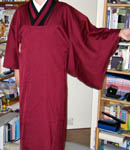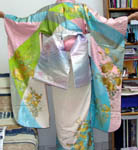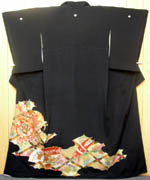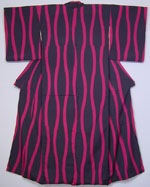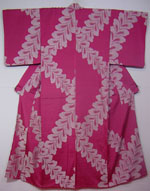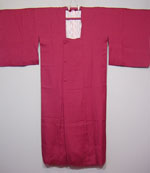This weekend I took a short trip to Paris, where among other things, I visited an exhibition at Mitsukoshi-Etoile, just near the Arc de Triomphe. The exhibition was on the history of Mitsukoshi, a prestigious Japanese department store with 300-plus years of history. As their beginnings were in kimono, much of it focused on kimono design. I’ve translated the French exhibition brochure, which is both interesting and informative. Family (last) names are in capitals.
This exhibition is a voyage into the history of a Japanese company, whose background melds with its home country’s economy and society. The exhibition combines company souvenirs and archives taken from its three centuries of existence.
1st floor
Reconstitution of the first store: Echigo-ya, specialized in sales of kimono fabric.
We are greeted by an ukiyo-e presenting the shop as it was originally: open on the sides, with clients sitting Japanese-style on tatami mats, while saleswomen show them fabric rolls. At front right, one saleswoman offers tea to a monk – the teapot can be seen behind Echigo-ya’s door. Behind these two people, a sword-bearing samurai enters the shop. At left, a group of customers around the cashier wait to hear the total for their merchandise. This attitude was brand new at the time: at Echigo-ya, payment was up front and in full. Previously, merchandise had been presented at the customer’s home, where the customer chose those goods that pleased them and paid later – weeks, even months later. The inevitable cash flow problems caused by this practice moved Echigo-ya’s founder, MITSUI Takatoshi, to come up with the system of direct payment that was to be the basis for his fortune. In a display case, we can see fabric and design samples from the 17th and 18th centuries, also a factor in the store’s success: these fabric samples were cut from kimono fabric rolls and given to customers for their perusal. A saying at that time was: “At Echigo-ya, you can hear silk being torn.” This was a compliment, as at the time, the idea was very novel.
In the large adjoining room, several ukiyo-e [ed.: most by Hiroshige] illustrate Edo’s atmosphere in the era of the same name (1615-1868). At the time, Edo was the most highly populated city in the world, and enjoyed peace and prosperity, favorable to a flourishing urban culture and economy based on interior trade. The art of ukiyo-e originated during this time, reflecting the capital’s amusements and attractions.
At left, reproductions of early photographs show us what became of Echigo-ya during the Meiji era: installation of the first European-style display cases, diversification of activities, and architectural transformations up to the Tokyo earthquake of 1923, which completely destroyed old Edo and took the lives of several thousands.
2nd floor
Old Edo has been totally lost, and Echigo-ya has become Mitsukoshi, a department store whose glory is still based on the quality and beauty of kimono, notwithstanding the modernization and diversification of products sold. The best period is that between the two World Wars. With a rich clientele and reasonable production costs, the store’s designers let their imaginations run wild, knowing that the extraordinary talent of Kyoto weavers allows them technical feats never before seen.
There are no kimono – all were sold. At such a level of “haute couture”, each kimono was unique, made for just one privileged wearer. We have only sketched designs and kimono fabric samples, visible in the display cases. Buyers would choose which colors they preferred.
Amongst the color furisode designs, whose motifs and color choices reveal something of the wearer’s personality, one in particular stands out. [Ed.: This refers to a furisode design with an amazing sho-chiku-bai motif done in dark, rich red on a black background. Dating from the 1920’s, the design was typically Taisho – large pine branch at bottom, plum blossoms nearly the size of one’s palm on gnarled plum branches flowing throughout the furisode, and three thick bamboo stalks going from hem to shoulder on the back – and yet it was bolder than anything I’ve ever seen from that period.]
In the second room we see uchiwa on one wall. These are summer fans which are not folded. They are used with yukata, lightweight summer kimono, and also as a way to present a letter, or as a geisha’s visiting card. The sketches and fabric samples are the most gorgeous of their time, bearing witness to artisans’ breathtaking skill. The grey silk sample, meant for a mature woman, shows a spider’s web in pine branches, symbol of longevity. [Ed.: The pine is a symbol of longevity, but I have never before seen a spider’s web on a kimono. What could it symbolize? There was a second fabric sample with a spider’s web on it, this time amongst falling red maple leaves, also on a grey background.]
In the third room are kimono worn for kabuki, donned by a famous actor [ed.: ONOE Kikugoro VI] in the 1920s and 30s, when Mitsukoshi lent and sold kabuki costumes to actors.
3rd floor
This floor displays posters from the early 1900s, made for advertising the store in train stations. These large images resembling Belle Epoque style show the island’s idea of beauty at the time: faces are expressionless, kimono are worn, gracefulness is all-important. Here and there we see hints of the exotic: European furniture, a French doll, ring on a finger – all illustrating the store’s modernity to prospective clients, while retaining traditional values.
This exhibition will be at Mitsukoshi-Etoile until July 5, 2003. Open Tuesday to Saturday from 2pm to 6pm, the address is: 3 rue de Tilsitt, Paris. Unfortunately, there is no book on sale for this particular exhibit, although there are books containing works from previous exhibitions on sale. Also, it is prohibited to take photographs of the exhibition.

